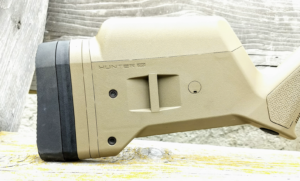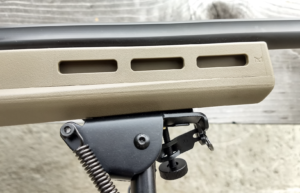As a tactical retailer, you may have seen recent announcements about Remington launching a Model 700 Magpul tactical bolt-action, and thought to yourself, “Old news. It came out last year!”
You’d be partially correct. In 2017, Remington did in fact introduce the Remington 700 Magpul bolt, clearly aiming for the tactical and long-range competition markets. That rifle sported a 22-inch barrel in short-action calibers and was decked out with a black Magpul stock.
However, Big Green entered 2018 by debuting another version of this rifle, the Remington 700 Magpul Enhanced. It’s “enhanced” in that Remington added more Magpul furniture to the package, colored in flat dark earth. The gunmaker also trimmed two inches off the barrel, reducing both the overall length and weight.
The Enhanced models were first offered in 6.5 Creedmoor and .308 Win. By the time you read this, Remington should also have 700 Magpul Enhanced versions in 6mm Creedmoor and .300 Win. Mag. in distribution channels.

The Remington 700 Magpul rifle has a host of features designed for hunting and shooting. (Photo: Brian McCombie)
After spending time using the rifle, it looks like Remington has produced a winner — a rifle suited for long-range shooting competitions and various tactical scenarios. It should also make a first-rate hunting rifle for the long-range crowd. And the Magpul furniture will be attractive to the tactical shooter and long-range hunter as well as very functional.
The 700 Magpul Enhanced I received was chambered in 6.5 Creedmoor. After cleaning the bore and the bolt, I took the rifle to my local range and fired off 20 rounds, cleaning the bore every few rounds to break-in the barrel. After a few shots, I realized that my scope was malfunctioning, so I didn’t worry about accuracy and finished off the ammunition box to speed the break-in process.
Before my second range session, I installed a new Leupold VX5 HD 3-15x44mm scope. Initially, I zeroed the rifle at 50 yards with Sig Sauer Elite Performance Ammunition, firing a 120-grain solid copper bullet, then I moved on to 100-yard targets. I spent two hours in this shooting session, plus another couple hours during a third trip to the range.
In addition to the Sig Sauer Elite, my accuracy testing included Federal Premium’s Non-Typical Whitetail with a 140-grain soft-point bullet and Remington’s Premier Match launching a 140-grain open-tip match bullet. I cleaned the rifle’s bore after every box of ammunition, using bore cleaner and a copper brush, and let the rifle cool a good ten minutes once it was cleaned.
Accuracy was impressive. At 100 yards and firing from a rest, my best five-shot group was 0.81-inch with the Remington Premier Match ammunition. The Sig ammunition produced several five-shot groups right at 1 inch, while the Federal Non-Typical Whitetail averaged very respectable 1.21-inch clusters for five shots.
Given the handful of times I was able to cloverleaf three of my five shots (almost always the first three shots), the 700 Magpul Enhanced strikes me as a sub-MOA rifle. My best groups were shot during my third range session, and it was clear to me that my accuracy improved as my familiarity with the rifle and scope grew. I do think the long-range competitor, tactical shooter or hunter who installs a quality scope and is willing to put in the needed range time should be able to print 0.50-inch groups with this rifle, all day, every day.
Part of that accuracy is due the rifle’s first-rate trigger. Admittedly, quality triggers and Remington 700 rifles haven’t always been synonymous. The nature of past Remington 700 triggers have made many an after-market trigger manufacturer a tidy sum, but the 700 Magpul Enhanced features Remington’s X-Mark Pro adjustable trigger. Creep-free, mine broke at a very clean 3.5 pounds. Remington engineers tell me the trigger is adjustable plus or minus a half-pound. My trigger felt great right out of the box, so I didn’t tinker with the pull weight.
The rifle’s Magpul hardware starts with a lighter-weight Magpul Hunter stock, made from reinforced polymer constructed around an anodized aluminum bedding block. It’s comfortable on the shoulder and the forend narrows towards the front proving an easy grip for the non-shooting hand.
When I first shouldered the rifle, I found the cheek weld too low. Good news: The rifle came with three Magpul cheek risers, and they are easily changed out by simply removing a single screw near the rear of the stock. Removing the screw also allows you to add or remove spacers between the butt pad and the stock to adjust length of pull from 13 to 15 inches. The rifle kit included four of Magpul’s 1/2-inch butt spacers.
The Magpul Hunter stock also features a flat-bottomed forend that allows for a more stable base when shooting off bags or flat surfaces. M-LOK slots on the forend’s sides and bottom provide ample space and attachment points for a wide variety of accessories and various sling mounting options.
The 700 Magpul Enhanced also comes standard with a bipod (no manufacturer’s name on the one I received). Using the bipod first required me to attach the Magpul M-LOK mount under the barrel. Easily done. That M-LOK mount, of course, can also be attached to the slots along the side of the forend for other accessories.
The 700 Magpul Enhanced includes a 10-round Magpul detachable box magazine. The Magpul magazine well uses a butterfly-style magazine release located just in front of the trigger guard. That release worked well for me; easily popping out the magazine.
The muzzle on the 20-inch, fluted barrel is threaded 5/8x24 and is suppressor- or muzzle-brake ready. Lastly, the rifle employs the workhorse Remington 700 action featuring two stout lugs and an oversized bolt handle. The bolt worked smoothly throughout my testing.
With so many tactical and long-range bolt actions on the market today, how might a retailer sell the new Remington 700 Magpul Enhanced? Seeing is believing!
According to Eric Lundgren, Remington’s Senior Product Manager for Rifles, one of the best ways to interest potential customers in the 700 Magpul Enhanced is to let them get a good, long look at the rifle. And that means getting one off the gun racks.
“Fully set up the rifle on a shelf — maybe over the gun racks — to show customers that the bipod and M-Lok attachment are included,” Lundgren advised. “That will also show off the flat dark earth finish and the Magpul look. For additional sales, think about matching the rifle with an appropriate optic to help initiate a scope sale. If you have other items for the long-range shooter that will fit on the shelf, like shooting bags or wind gauges, consider placing them there, too.”
Having access to a few tools behind the counter can also be a big sales help.
“I think stock adjustability is big here for the tactical style shooter,” Lundgren added. “The rifle comes with a straight, medium and high comb and a spacer kit for stock adjustability. Have you and your staff practice changing out the combs and spacers, and then show a customer how easy it is to actually do this.”
Obviously, competitive and tactical shooters are the main customer base for the Remington 700 Magpul Enhanced. But don’t be shy about recommending the rifle to hunters.
“While this rifle is on the heavy side, I consider this rifle to be a hunting/tactical hybrid,” says Lundgren. “It is appropriate for both longer range shooting, especially suppressed, and hunting.”
He noted that the original 700 Magpul with the 22-inch barrel was a bit unwieldly when a suppressor was attached. The shorter barrel on the Enhanced model makes the rifle-suppressor combo a little more user friendly, especially in tighter confines.
For marketing purposes, Lundgren said Remington was working with some tactical shooters and longer-range hunters to provide Remington’s social media with written and video content showing the rifle in action in various venues.
With the growing interest in long-range shooting competitions, Lundgren also hoped to have a professional shooter or two using the 700 Magpul Enhanced on the various competition circuits.
Remington will also be devoting significant resources to promoting the 700 lines of bolt-action rifles in general, and Lundgren said the 700 Magpul Advanced would see some of this effort, too.
Featured image: Brian McCombie






